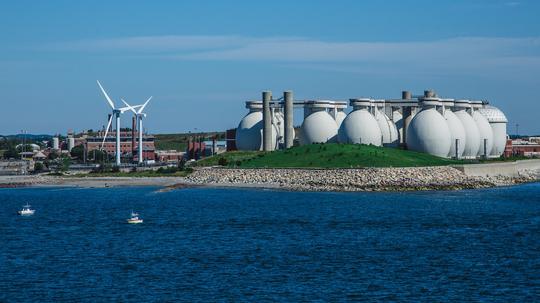
This is the first story in our "Green Tech" editorial series, which is running several stories on clean tech startups and trends in the Boston innovation ecosystem during the week of October 22, 2018.
Thinking of “clean energy” as opposed to “dirty energy” is a great way to begin understanding the energy industry.
Experts use slightly different words: renewable sources versus non-renewable sources. The statute of the Massachusetts Clean Energy Center, for example, defined clean technologies as the ones that “significantly reduce or eliminate the use of energy from non-renewable sources.”
With the final goal of becoming independent from fossil fuels, the world is going to need a more efficient use of natural resources. Applications of clean tech are not limited to electric vehicles and solar panels, but include new techniques of energy efficiency and storage (enter: new batteries).
Local startups like Magnomer, which is developing magnets to properly sort plastic during recycling, or Infinite Cooling, which is using electric fields to reduce water usage in power plants, fall within the label of clean tech, too—and they both won significant cash prizes at this year's MassChallenge Awards.
Not surprisingly, clean energy innovation comes with its unique set of challenges. First, it requires a deep understanding of global issues like climate change and carbon emissions—combined with highly-specialized expertise in engineering and material sciences.
“Reducing energy use in our buildings, in our vehicles, improving efficiency in our grid and power generation, identifying new and improving existing energy generation sources… These are really, really tough problems,” said Galen Nelson, senior director for innovation and industry support at MassCEC. “[They] require a lot of engineering and often require hardware development.”
Second, there are timelines to take into account. Not only can’t masses ditch fossil fuels until a sustainable alternative is in place, but global, national and state goals to reduce pollution push towards taking fast action.
In 2008, Massachusetts was one of the first states in the nation to move forward with a comprehensive regulatory program to address climate change — which comes with an ambitious timeline. Such goals have trickled down to action at the local level: In October this year, Boston was one of 20 winners of the Bloomberg American Cities Climate Challenge, a $70 million program that aims to accelerate cities’ efforts to tackle climate change.
Third, energy research and development is capital-intensive and time-consuming, two adjectives that early-stage venture investors don’t usually like to hear.
Luckily for clean energy startups in Boston, the local ecosystem offers several resources to overcome these challenges. But this wasn’t always the case.
The Making of a Bad Reputation for Clean Energy Investing
Clean energy (or green energy) innovation is a relatively new field. The Department of Energy has only been in existence since 1977, so it’s almost two centuries younger than the Department of Justice, one of the first agencies of the federal government. Since the late 1990s, DOE has been addressing energy, environmental and nuclear challenges through science and technology—a mission marked by the U.S. commitment (later withdrawn) to cut greenhouse gas emissions as part of the 1997 Kyoto Protocol.
The pace of national innovation in clean tech hit the gas around the same time. Overall, renewable-energy patents in the U.S. increased from fewer than 200 per year in the period from 1975 to 2000 to more than 1,000 annually by 2009, according to an MIT report.
Then, innovation faltered. In the aftermath of the 2008 financial crisis, the drying up of available capital combined to a few, concurrent spectacular failures in the sector (like Californian solar manufacturer Solyndra in 2011) ended up creating a bad reputation around the clean energy industry among the limited partner community; therefore, among VCs.
“The word got out that it’s a bad place to invest,” said Rob Day, general partner at Spring Lane Capital, a Boston-based VC firm that backs entrepreneurs in the energy, water, food and waste industries. “That you can’t make a venture capital return there.”
Around the same time, cap and trade policies aimed at reducing greenhouse gas failed on Capitol Hill, and “it was the cherry on top of the story,” Day said. “Conclusions were drawn.”
However, the reality wasn’t that bad, and clean tech innovation quietly kept growing behind the scenes. In 2015, for example, solar power reached 1% of global energy supply in 2015.
“Thank goodness a lot of entrepreneurs with a lot of passion continued to be very interested,” Day said. “These markets continued to grow very well; you also continued to see a lot of world-class innovation at the various research institution, particularly in Boston.”
The MIT Energy Initiative, a designated lab on campus for energy research, education and outreach, was announced in 2005. Moreover, Massachusetts is known as a research hub on lithium and ion batteries (a segment of clean tech that has been instrumental for the electric vehicle industry), conducted at MIT and in companies like Woburn-based Ionic Materials.
Nowadays, the local clean tech innovation scene is nothing but well-established, as proven by the numbers.
The Numbers of Clean Tech in Massachusetts
The 2017 Massachusetts Clean Energy Industry Report – an annual accounting of the sector’s activity – showed that the clean energy sector continued to report sustained growth, expanding to more than 109,000 jobs between 2016 and 2017.
The industry contributes $11.4 billion to Massachusetts’ Gross State Product and represents a 2.3 percent share of the entire Massachusetts economy. It also grew by 4 percent since the 2016 report and by 81 percent – 49,000 more workers – since 2010.
!function(e,t,n,s){var i="InfogramEmbeds",o=e.getElementsByTagName(t)[0],d=/^http:/.test(e.location)?"http:":"https:";if(/^\/{2}/.test(s)&&(s=d+s),window[i]&&window[i].initialized)window[i].process&&window[i].process();else if(!e.getElementById(n)){var a=e.createElement(t);a.async=1,a.id=n,a.src=s,o.parentNode.insertBefore(a,o)}}(document,"script","infogram-async","https://e.infogram.com/js/dist/embed-loader-min.js");
The Growth of Jobs in the Clean Energy Sector in Massachusetts (2010-17) Infogram
Such a strong performance is necessary given the ambitious goals that the Commonwealth has in place. “Our effort to address the State’s very aggressive and very nation-leading climate goals require equally aggressive and ambitious investments in energy innovation,” Nelson said. “We can’t solve our climate challenges with deployment [of existing technologies] alone.”
An analysis included in the 2015 update to the Massachusetts Clean Energy and Climate Plan for 2020 said that a greenhouse gas emissions reduction of at least 25% by 2020 is attainable, provided there is consistent effort and collaboration across all sectors. Achieving that mission would be only the first piece of the puzzle, as in 2008, the State has committed to reduce its emission of 80% by 2050.
To succeed, the Boston-based clean tech community can count on a few, unique strengths. Compared to Silicon Valley, Boston has the patience and the talent capital to perform technical work, assets that are crucial in clean tech, without being overly obsessed with the search for the next unicorn.
“The Boston-based community is more interested in the harder engineering problems, and trying to build financially-sustainable businesses,” Day said. “We see a lot of companies in this area that may not be as well-known as startups on the West Coast, but they’ve actually sold systems.”
Success, however, cannot be reached without a crucial initial asset—money. Thankfully, VCs are not the only resource for clean energy startups to raise funding.
The Investment Ecosystem
As former CEO of a Marlborough-based clean tech company, Phil Giudice admitted that getting the right investors was one of his primary challenges. His company, Ambri, used liquid metal battery technology to produce low-cost and long lifespan systems—a vision that, as for many clean tech products, requires long-term commitment. “There’s a lot of investors who want to get involved in things, but don’t have the appetite or capability of being there for the long call,” he said.
One of Ambri’s investors is Total, one of the major international oil and gas companies. To “prepare for the future,” the company said it continually innovates to produce sustainable and responsible energy solutions in oil and gas, but also solar energy and bioenergies.
Locally, one resource that Massachusetts clean tech entrepreneurs can count on for funding is the investment division of The Massachusetts Clean Energy Center (MassCEC), which is dedicated to “build the clean energy economy” to support the State’s environmental goals, said Director of Investments Tibor Toth.
The division acts like the venture capital arm of MassCEC, investing directly in local clean tech companies (mostly, early-stage) across different sectors, including energy efficiency, demand management and clean transportation.
Also, entrepreneurs receive support in overcoming “widely recognized funding and other gaps in clean energy development cycle,” said Nelson, who added that the MassCEC investments are grants that are mostly matched with private and public sector dollars. “The support from the federal government only goes so far,” he said. “Our effort to address the State’s very aggressive and very nation-leading climate goals require equally aggressive and ambitious investments in energy innovation.”
Local universities, too, take clean energy research and entrepreneurship into serious consideration. MIT’s The Engine, the accelerator for “tough tech” companies that manages a fund of $250 million, selected four clean energy startups among its first cohort of 13 startups. Their specialization range from building a new, superconducting engine to designing long term-storage batteries. Also, with the MIT Energy Initiative, the school provides financial support and access to research to U.S. energy startups, even the ones that aren’t affiliated with MIT.
Recently, an MIT startup scored some illustrious funding. Commonwealth Fusion Systems, which believes it can bring fusion power to market in 15 years, was partly funded by Breakthrough Energy Ventures, a fund led by a group of billionaires, including Bill Gates, Jeff Bezos, Jack Ma, Mukesh Ambani and Richard Branson.
The Future of Clean Tech Innovation
If the world of startup founders were a kitchen, their mission would be to invent a new meal from scratch. Their only guidance would be the belief - the faith - that the new combination of flavors will eventually taste good.
If the world of clean energy startup founders were a kitchen, they’ll have to cook a newly-designed meal by overcoming additional challenges. The final plate would require ingredients that have different preparation and cooking times; qualified sous-chef would be limited; pans would cost millions; and, as it always happens, no recipe is provided.
But the passion for “saving the world” can go a long way. Especially in green tech innovation.
Next up on the series: Is impact investing a thing in Boston?








